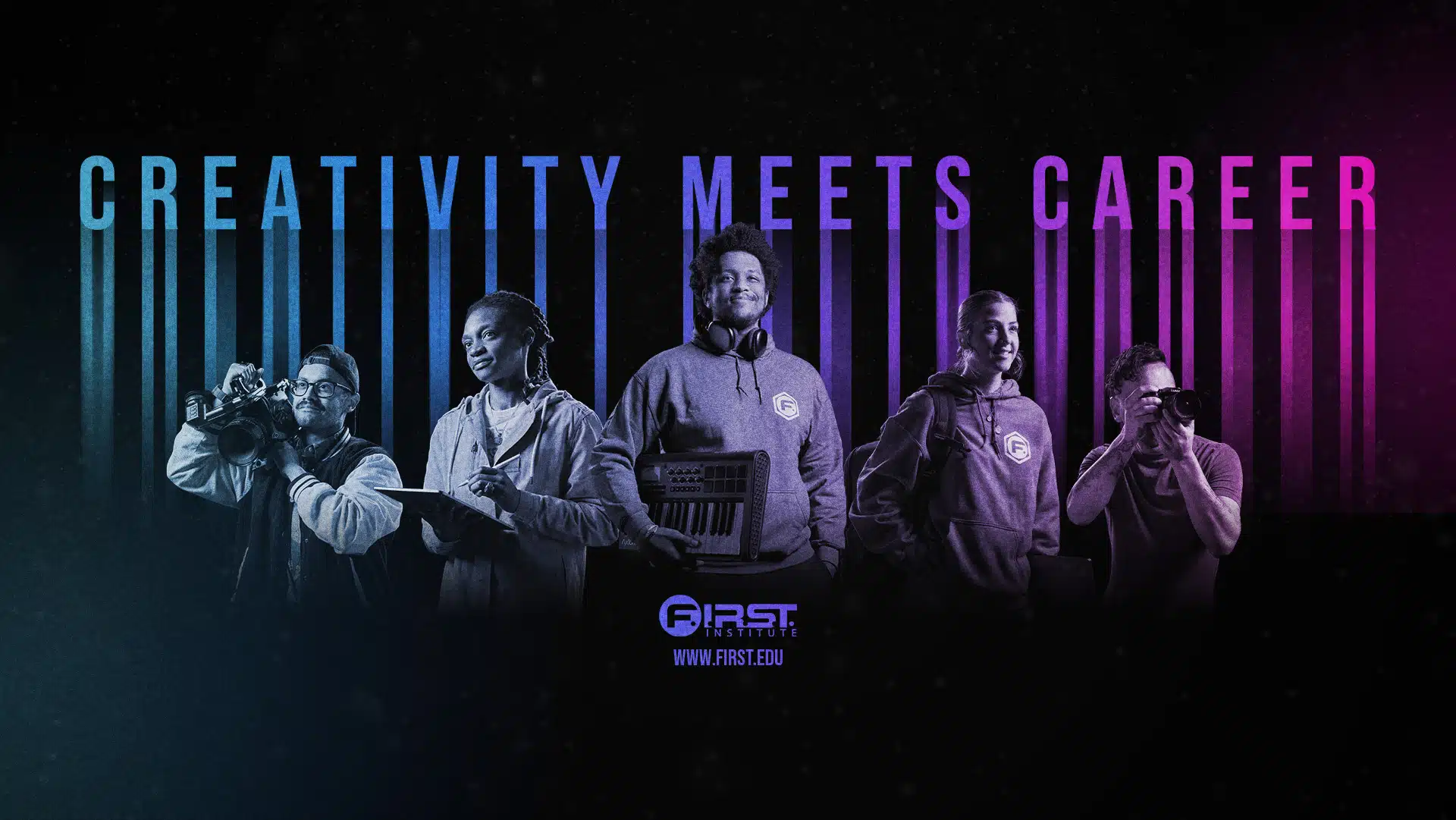PROGRAMS
Graphic Design & Web Development
The Graphic Design & Web Development program is designed to prepare students for the real world of digital-based graphic design and web development. The web changes rapidly, and we strive to keep our curriculum updated to reflect actual trends in an ever-growing and fast-paced industry. We take advantage of the vast number of open-source frameworks, tools, and software available for the web-based content creation.
Our program explores multiple areas of design and development, focusing on core areas that are practical for the modern designer. This program begins with establishing basic computer skills, digital media design fundamentals, illustration, and basic photography. Students will then progress to advanced concepts of front-end web programming. Having a broad scope of knowledge makes for a more competent and skilled professional, opening greater opportunities for our graduates.
Every course will assess students on weekly objectives with regular exercises and projects. The result of program completion is a well-rounded graduate with the diverse skill set necessary to get an entry-level career in the field of graphic design and web development.
Prerequisite: Basic computer and internet competencies. High school level English or higher.
Delivery Methodology: Campus
Average Class Size: 16 Students
Upon successful completion of the program, graduates obtain a Diploma.
Thirty-Nine (39) Weeks – 1014 Clock Hours / 91.26 Academic Quarter Credit Hours
811 Hours / 81.11 Academic Quarter Credit Hours – Instruction 203 / 10.15 Academic Quarter Credit Hours – Lab
- Program Name Graphic Design & Web Development
- Total Clock Hours 1014
- Hours - Instruction 811
- Hours - Lab 203
- Your Creative P.A.K. (Included)
- Class Materials (Required)
- GDWD 101 – Graphic Design Principles
- GDWD 102 – Digital Illustration
- GDWD 103 – Photoshop and Digital Photography
- GDWD 104 – UI/UX Design
- GDWD 105 – Web Design and Development
- GDWD 106 – Motion Graphics
- GDWD 107 – Layout Design
- GDWD 108– Graphics and Web Portfolio
Students in our Graphic Design & Web Development program receive a Creative P.A.K. to use during the course of their program and beyond. The digital media industry and its relevant technology are ever-changing, so specific items in your Creative P.A.K. may be updated from time to time.
- Apple iPad Air
- Apple Pencil
- Canon EOS R100 Mirrorless Camera with 18-45mm Lens
- SanDisk 64GB Extreme Pro UHS-I SDXC Memory Card
- Angler Port-a-Cube LED Mini Light Tent with Dimmer II (16”)
- XILETU XSG-3 Lite Mini Tripod with 360-Degree Ball Head and Selfie Stick
*Specific items are not guaranteed. Contact the school for more information.
Students are required to be prepared for class. This includes having these items at all times: pen, writing paper/notebook, ID badge, and all required materials for their program. The following required items are not included in the tuition. It is the student’s responsibility to purchase the items for use on their first day of class.
- Computer Requirements (Click Here)
- Adobe Creative Cloud Account
- Student discount is available
- To receive the student discount you must sign up for the annual plan that is paid monthly.
- Hard Drive
- Minimum storage size 1TB
- Must be Mac compatible (campus)
- Sketchpad
- Graphite Pencils
Recommended:
- Notebook
- Pens/Pencils for taking notes
Students learn a basic understanding of computers, their parts, and terminology for the first week of Graphic Design Principles. After learning the fundamentals of computing and developing a good understanding of the diverse types of digital media formats, students get a sneak peek at the Adobe Creative Suite of Products, a set of tools widely used in the Graphics and Digital Design industry. F.I.R.S.T. then introduces them to art history and the evolution of visual arts in relation to the development of modern design principles and standards as a foundation for contemporary visual design and color theory.
Classes will then be introduced to Typography and Design Processes. Important skill sets are then developed through studies on Creative Thinking, Research and Concept Development, Business Communications, Client Briefing and Analysis, Digital Printing, and the importance of the print production processes. Students learn Branding fundamentals and then examine marketing in relation to corporate and personal branding and social media.
GDWD 101 – Graphic Design Principles
- Custom Logo Project
- Style Guide Project
- National Parks Poster Project
- Book Cover Project
Students first learn about the concept of illustration. Classes then introduce Adobe Illustrator, an industry standard used primarily in creating vector graphics and line art.
The Adobe Illustrator user interface, workspace, and tools are learned through demonstration and exercise. As skills are gained, students go from creating simple vector shapes to more advanced vector illustrations and graphics. Students will use the skills learned in Illustrator to complete several projects, including logo design and other creative illustrations.
GDWD 102 – Digital Illustration
- Creative Portrait Project
- Character Design Project
- Styled Architectural Illustration Project
In this course of study, students are introduced to digital photography and camera basics. They will learn how to set up cameras with lighting considerations and use them in real photo shoots. Photographs from Digital Photography are some of the images used to learn key photo selection and editing skills.
Adobe Photoshop is an industry standard for creation, editing, and photo manipulation. From the technical processing of multiple images to making unique artwork and digital paintings, Photoshop is used by animators, graphic designers, web designers, photographers, architects, and more. Throughout this course, students are introduced to the many tools and features of this powerful raster graphic editing software. Building on the skills learned, more advanced features, effects, and techniques are taught using demonstration and hands-on exercises. Students will then utilize their new knowledge of the tools combined with personal artistry to create several portfolio-worthy graphics projects.
GDWD 103 – Photoshop and Digital Photography
- Product Photography Project
- Portrait Photography
- Photo Collage Project
- Digital Ad / Web Banner Project
Students are introduced to a brief history of UI/UX, including the language and vocabulary associated with it. Professional concepts in User Experience and User Interface Design, such as wireframing and prototyping, are learned during this course. Students gain knowledge of important design considerations for websites and applications to make them practical for all users.
Students gain an understanding of how to facilitate an easy end-user experience through meaningful and purposeful interface design. Skills are gained through practical exercises in the layout and positioning of web application content and elements. This is done through design research, wireframes, mock-ups, and prototyping. Several projects are completed that apply the UI/UX app design skills learned.
GDWD 104 – UI/UX Design
- GUI (Graphical User Interface) Project
- App Design Project
Daily internet interaction is an integrated way of life for individuals and businesses. Students are introduced to HTML as a markup language, the foundation for building structure on websites. Just as language is often broken down into basic words or elements, so are coding-related languages. Students will learn about HTML elements as the fundamentals of the language and the dynamic results that are produced through its use.
The course will then examine the importance and necessity of inclusion for all to have equal participation in the use of the web through accessibility. Students will also be introduced to CSS, the language that transforms the basic structure of HTML and applies the visual display and presentation of web pages through responsive design.
After practicing how to develop a website from scratch, students are introduced to some basic grid-based layouts through templates. At this point, students are learning introductory concepts in how webpages are made to be interactive and engaging to the end user. Content Management Systems such as WordPress are integral to a significant percentage of existing sites on the web.
These systems make creating and managing digital content easier for both consumers and designers alike. Time in WordPress is spent on how to modify existing templates and using the advanced features included in them.
GDWD 105 – Web Design and Development
- HTML Potluck Project
- Generic License Project
- Mebay Product Page
- Custom Portfolio Template Project
After developing strong skills in Typography, Illustration, and Photo Editing, along with an understanding of the web, students are now taught the techniques needed for putting design assets and graphics into motion.
Motion theory is introduced at the beginning of the course to give students a sound foundation in the concepts needed to execute projects successfully. Students will learn technical skills that follow the principles of animation through keyframing, image positioning, masking, and other visual effects.
Projects are developed with the goal of helping students grow in their creative problem-solving skills, which will then be utilized in executing various motion graphics principles.
GDWD 106 – Motion Graphics
- Animated Logo Project
- 3D Scene Project
- Lower Thirds Project
Understanding how various design elements are combined to create successful visual communication is the basis of this course. Students begin with an introduction to the art of digital layout using the elements and principles of design.
Exercises in how to create good compositions are done through design challenges. Next, students take some time to apply and further grow their layout and design techniques while learning Adobe InDesign, an industry standard. Using InDesign, students will create several projects, such as catalogs and brochures, and then go on to develop a print campaign for their course project.
GDWD 107 – Layout Design
- Editorial Magazine Layout Project
- Banner Project
- Xbox Controller Wrap
In the Web and Graphics Portfolio course, students cumulatively refine and perfect previous
projects to a finished and finalized form. This is accomplished in part through professional review and critique. The body of work from earlier courses, GDWD 101 through GDWD 107, is included during this last stage of the course.
Students leave the program with a diverse, strong, and, most importantly, professional-level portfolio that showcases their abilities in graphic design, motion, and front-end web design & development.
GDWD 108 – Graphics and Web Portfolio
- Final Portfolio
- Final Resume
- Final Cover Letter
Admissions & Financial Aid
Admissions Process
Personalized Tours – Our admissions team is dedicated to helping you find a program that best fits your goals. Take an in-person or virtual tour to see how F.I.R.S.T. can help you.
Apply Anytime – With class starts occurring every other month, you can apply now and find a start date that works best for your schedule
Flexible Schedules – Classes meet in the morning or evening allowing you to find one that best fits your busy schedule.
Funding Your Education
Tuition – Our tuition covers the entire program cost, including access to equipment and production facilities on campus, as well as the Creative P.A.K.
Federal Aid – We strongly encourage incoming students to explore financial aid options. Pell Grants and student loans are available to those who qualify.




